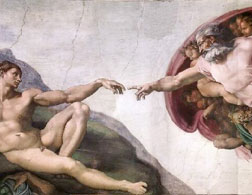Labor Pains
Michelangelo's poem about the awkward parturition of the Sistine Chapel.

After a certain point, reverence can become automatic. Our admiration for great works of art can get a bit reflexive, then synthetic, then can harden into a pious coating that repels real attention. Michelangelo's painted ceiling of the Sistine Chapel in the Vatican might be an example of such automatic reverence. Sometimes, a fresh look or a hosing-down is helpful—if only by restoring the meaning of "work" to the phrase "work of art."
Michelangelo (1475-1564) himself provides a refreshing dose of reality. A gifted poet as well as a sculptor and painter, he wrote energetically about despair, detailing with relish the unpleasant side of his work on the famous ceiling. The poem, in Italian, is an extended (or "tailed") sonnet, with a coda of six lines appended to the standard 14. The translation I like best is by the American poet Gail Mazur. Her lines are musical but informal, with a brio conveying that the Italian artist knew well enough that he and his work were great—but that he enjoyed vigorously lamenting his discomfort, pain, and inadequacy to the task. No wonder his artistic ideas are bizarre and no good, says Michelangelo: They must come through the medium of his body, that "crooked blowpipe" (Mazur's version of "cerbottana torta"). Great artist, great depression, great imaginative expression of it. This is a vibrant, comic, but heartfelt account of the artist's work:
Michelangelo: To Giovanni da Pistoia
"When the Author Was Painting the Vault of the Sistine Chapel"
@@@@@@@@@@@@@@@@@@@@@@@@@@@@—1509
I've already grown a goiter from this torture,
hunched up here like a cat in Lombardy
(or anywhere else where the stagnant water's poison).
My stomach's squashed under my chin, my beard's
pointing at heaven, my brain's crushed in a casket,
my breast twists like a harpy's. My brush,
above me all the time, dribbles paint
so my face makes a fine floor for droppings!
My haunches are grinding into my guts,
my poor ass strains to work as a counterweight,
every gesture I make is blind and aimless.
My skin hangs loose below me, my spine's
all knotted from folding over itself.
I'm bent taut as a Syrian bow.
Because I'm stuck like this, my thoughts
are crazy, perfidious tripe:
anyone shoots badly through a crooked blowpipe.
My painting is dead.
Defend it for me, Giovanni, protect my honor.
I am not in the right place—I am not a painter.
Click the arrow on the audio player below to hear Robert Pinsky read "When the Author Was Painting the Vault of the Sistine Chapel." You can also download the recording or subscribe to Slate's Poetry Podcast on iTunes.
He is "not a painter"! The hint of rhyme between "honor" and "painter" in Mazur's translation gives some suggestion of a clinching couplet. (The rhyme—onore/pittore—is much more distinct in the Italian original.) Although Michelangelo may, in part, have intended "I am really a sculptor—not a painter," despair is certainly there in his self-description. I like to imagine his friend Giovanni laughing out loud at his final "nè io pittore," as we—anyone who has had a hard time at work on a demanding project well worth doing—can add our own exclamation of astonishment, rue, and amusement.
Slate Poetry Editor Robert Pinsky will be participating in the Poems "Fray" this week. Post your questions and comments on "When the Author Was Painting the Vault of the Sistine Chapel," and he'll respond and participate. (In the interest of keeping the discussion as rich as possible, please read existing comments before posting your own.) You can also browse "Fray" discussions of previous classic poems.